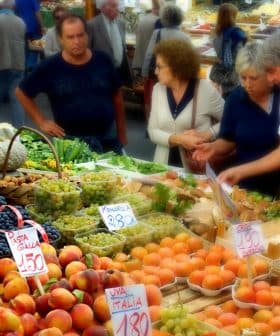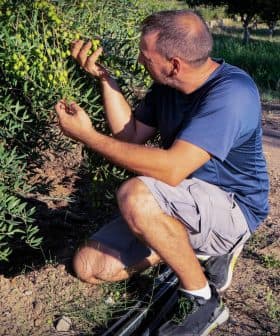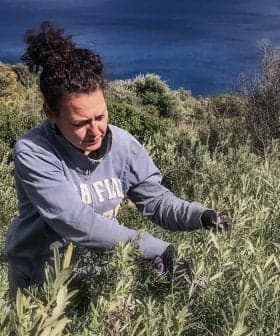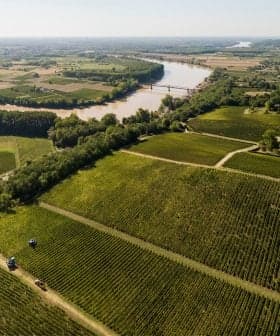New Zealand Producer Uses Brix Levels to Determine Ideal Harvest Moment
Unlike with grapes or other fruit, Ross Vintiner harvests olives when the sugar level falls, indicating that oil is accumulating and polyphenol content remains high.
 Ross Vintiner uses Brix readings from his olives to help determine the ideal moment to harvest.
Ross Vintiner uses Brix readings from his olives to help determine the ideal moment to harvest.  5.3K reads
5.3K readsRoss Vintiner, an award-winning New Zealand producer, is developing a cost-effective method to determine the best time to harvest olives to balance high yields with polyphenol content, based on his grape-growing experience. By measuring Brix levels of olive juice and predicting oil content, Vintiner has created a harvest index that allows him to achieve high phenolic compounds and reasonable oil yields per cultivar, resulting in consistently high total polyphenols in his olive oils. Vintiner’s innovative approach to olive growing and olive oil production has led him to develop new fertilizing methods, including using olive pomace to double the soil organic matter in his groves. He has also pioneered new ways of fertilizing olives within the confines of organic certification and biodynamic practices, achieving optimal growth and fruit fill through micro-dosing fertilizers and using a mix of fermented plants to support soil health.
Building on his grape-growing experience, one award-winning New Zealand producer is developing a cost-effective method to determine the best moment to harvest his olives to balance high yields with polyphenol content.
Ross Vintiner, co-owner of The Vintiner’s Grove, told Olive Oil Times in April that he was developing a harvest schedule to optimize the content of polyphenols and other antioxidants in his extra virgin olive oils.
By measuring Brix levels of olive juice and predicting oil content, I could better estimate harvest time to achieve high phenolic compounds and a reasonable oil yield per cultivar.
Based in the Wairarapa region on the North Island, Vintiner said the experiment was based on his previous experience, but he soon found research to back it up.
“I discovered later that Spanish research verified my working assumption,” he told Olive Oil Times.
See Also:Genotype Plays Significant Role in Fatty Acid Content of Virgin Olive OilVintiner said he independently observed that it is best to harvest when the Brix readings of his olives fall, the reverse of what is done across fruit industries. “I harvest when Brix levels fall for each variety, the opposite to [what] a winemaker [would do],” he explained.
“Research shows that unlike grapes where maximum Brix is required to harvest, in olives minimum sugar – Brix levels – equals maximum oil and total polyphenols,” Vintiner said. “This is an inexpensive way of determining my harvest time. A refractometer to measure Brix costs around $100 New Zealand (€57).”
Brix readings
Brix readings are a measure of the sugar content in a liquid, typically in the context of measuring the sweetness of fruit juice, wine or other beverages. The Brix scale is based on the refractive index of the liquid, which changes in proportion to the amount of dissolved sugar. Brix readings are expressed as a percentage, and a higher Brix reading indicates a higher sugar content. In agriculture and food production, Brix readings are often used to determine when fruits or vegetables are ripe enough for harvest or to monitor the progress of fermentation in wine or beer-making.
“Around a decade ago, following my experience of grape growing, I was curious: Was there a relationship between olive fruit ripening, oil content and sugar levels in olive fruit?” he recalled.
Vintiner then started measuring the Brix levels of olive leaves and fruit and found that rising readings of the leaf sap indicated rising readings of the olive fruit juice.
“Then Brix levels fell, the opposite of grapes, coinciding with physical signs of oil in the fruit,” he said. “Each cultivar was different.”
“A minimum value for sugar correlates to a maximum value for oil content,” Vintiner explained. “I observed the usual sugar levels and ripeness for each variety, counting maximum ripeness from days after full bloom.”
“These results enabled a predictive harvest index [a measurement of crop yield] for each variety,” he added.
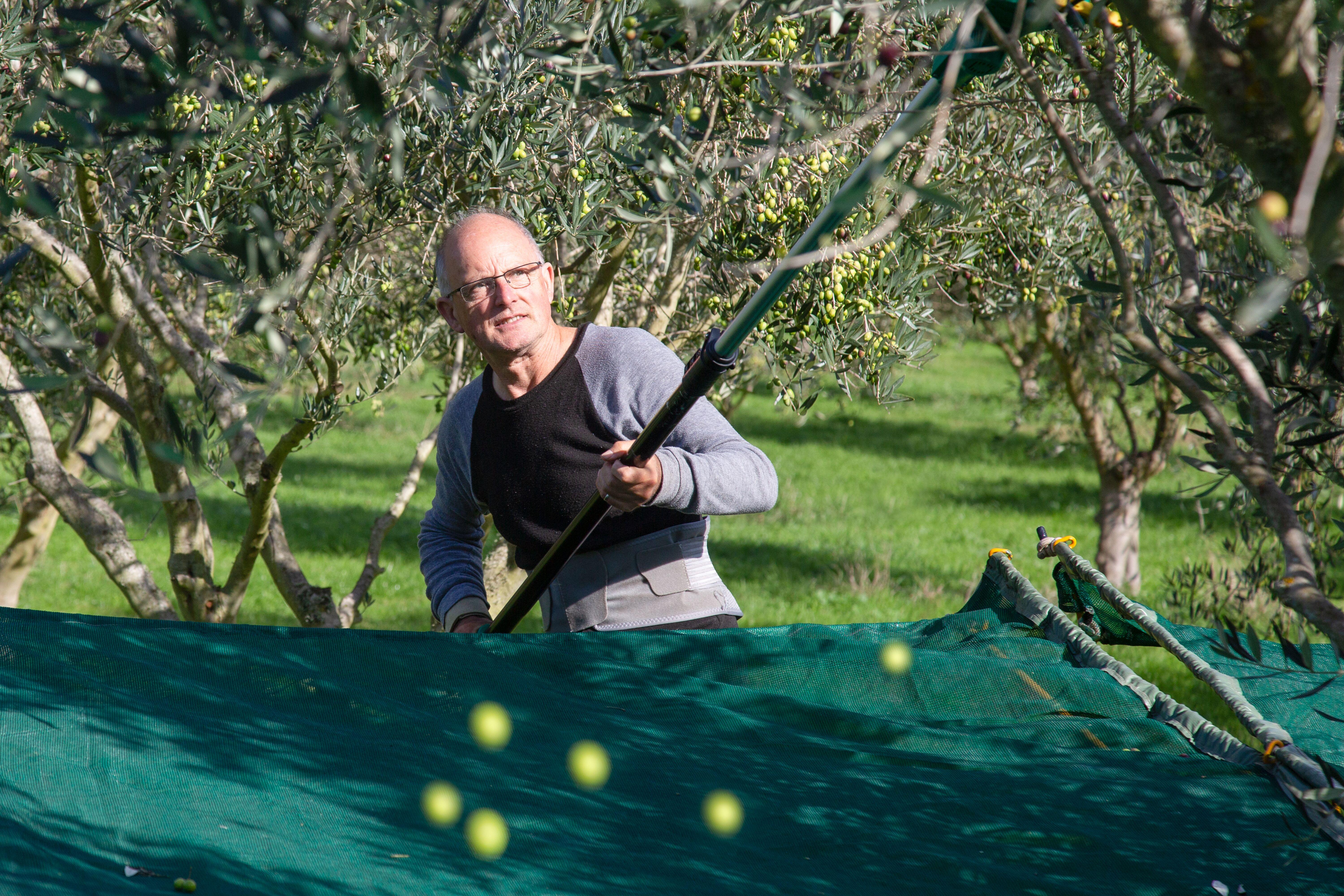
Vintiner harvesting olives.
Vintiner said he refined his approach by doing further research. “There is no strong correlation between sugar and phenolic compounds,” he said. “However, total phenolic compounds decrease during ripening.”
“As we harvest for high polyphenols and phenolic compounds decline during ripening, I overlayed typical polyphenol decline on the harvest index to estimate my harvest time,” Vintiner added. “I checked the index each year against sugar levels and polyphenol results to verify the model.”
“The index provides a reliable and acceptable trade-off to be made between harvest dates, oil content and polyphenols,” Vintiner said. “By measuring Brix levels of olive juice and predicting oil content, I could better estimate harvest time to achieve high phenolic compounds and a reasonable oil yield per cultivar.”
“A harvest index, unique to each grove, can be constructed that relates Brix oil content with likely phenolic levels,” he added.
Vintiner, who grows Frantoio, Koroneiki, Kalamata, Leccino, Pendolino and Picual trees at his Dali Estate, said he has been using the above model to consistently achieve high total polyphenols (with levels exceeding 250 milligrams per kilogram) for all these, as well as medium to high oil yields (except for his Kalamata table olives).
“Our best polyphenol oils are either at or near the top total polyphenol oils in New Zealand,” he said. “In my view, along with flavor, high phenolic olive oils define true quality and healthy olive oil.”
He said olive skin color is not a strong indicator of when to start harvesting in New Zealand. “Olive flesh color is often used, with white flesh to the pit indicating ripeness,” Vintiner said.
“There are also tests for fruit water content to determine ripeness,” he added. “Other farmers follow tried timing and experience. It is likely that real-time olive total polyphenols will soon be measured by a hand-held device.”
Vintiner said he runs more tests on all components of his groves than most olive growers and tests new ideas to guide informed decisions.
Vintiner’s innovative approach to olive growing and extra virgin olive oil production has also led him to develop new fertilizing methods. As a result, Dali Estate’s groves have doubled their soil organic matter – plant and animal waste at different stages of decomposition – in five years.

Dali Estate prides itself in its biodynamic farming practices.
Olive pomace is a recognized fertilizer, but Vintiner took a new approach. “I have pioneered new ways of fertilizing olives, including using olive pomace, all within the confines of Biogro (New Zealand’s main organic certification agency) organic certification and biodynamic practice,” Vintiner said.
Vintiner worked within these confines, as Dali uses only certified organic and biodynamic methods and inputs since Vintiner bought the property in 2011.
“I use our pomace in a ferment that takes about three weeks to mature and lasts up to two years,” he said. “Fermented pomace tested high in plant available nitrogen and potassium, essential for growth and fruit fill, respectively.”
“I use this diluted ferment as a foliar spray in spring and autumn,” Vintiner added. “As the ferment is low in microbial biomass – the mass of the living component of soil organic matter, a significant measure of soil quality – I add organic effective microorganisms [mixed cultures of naturally-occurring organisms] at low-percentage application.”
He said using research and his own experience, he has found that micro-dosing, applying fertilizers a little at a time and often, achieves the best results.
He also creates a mix of nettle, comfrey and lucerne fermented with kelp to produce a ground drench high in minerals olives most need. In addition, he has further supported Dali’s soil health by planting clovers, plantains and comfrey; together with other plants and trees, where his sheep graze and fertilize the soil.
Vintiner, with his knack for exploring uncharted territory, is the only grower of Kalamata olives – which he said are very high in phenolic compounds – in the Wairarapa region. “Kalamata trees grow well in the Wairarapa but have problems fruiting,” he said.
But he found methods to overcome this. “Using a variety of techniques, including planting on a sun-facing slope, annual pruning and companion planting with comfrey, Dali Kalamata fruit each year,” he said.
“I am passionate about growing the best soil, soil life and everything diverse above it,” Vintiner concluded.
Share this article



